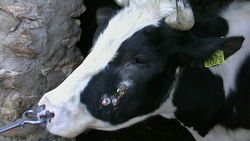Difference between revisions of "Mandibular Osteomyelitis"
| Line 12: | Line 12: | ||
'''Lumpy jaw''' is a chronic infectious condition which affects cattle. It is caused by the anaerobic filamentous bacteria [[Actinomyces bovis|''Actinomyces bovis'']] | '''Lumpy jaw''' is a chronic infectious condition which affects cattle. It is caused by the anaerobic filamentous bacteria [[Actinomyces bovis|''Actinomyces bovis'']] | ||
Actinomyces is a normal commensal of the oral cavity and upper respiratory tract of cattle, it gains entry to underlying soft tissue when the mucosa is damaged by trauma or eruption of teeth. | Actinomyces is a normal commensal of the oral cavity and upper respiratory tract of cattle, it gains entry to underlying soft tissue when the mucosa is damaged by trauma or eruption of teeth. | ||
| − | Lesions are charcterised by gross swelling, abscesses and draining fistulae overlying granulation of the madible and maxila. In some cases the [[Oesophagus|oesophagus]] and [[Oesophageal groove|oesophageal groove]] may become involoved but the lymph nodes not affected. | + | Lesions are charcterised by gross swelling, abscesses and draining fistulae overlying granulation of the madible and maxila. In some cases the [[Oesophagus - Anatomy & Physiology|oesophagus]] and [[Oesophageal groove|oesophageal groove]] may become involoved but the lymph nodes not affected. |
==Signalment== | ==Signalment== | ||
Revision as of 20:30, 26 July 2010
| This article is still under construction. |
Description
Lumpy jaw is a chronic infectious condition which affects cattle. It is caused by the anaerobic filamentous bacteria Actinomyces bovis Actinomyces is a normal commensal of the oral cavity and upper respiratory tract of cattle, it gains entry to underlying soft tissue when the mucosa is damaged by trauma or eruption of teeth. Lesions are charcterised by gross swelling, abscesses and draining fistulae overlying granulation of the madible and maxila. In some cases the oesophagus and oesophageal groove may become involoved but the lymph nodes not affected.
Signalment
The condition affects cattle 2-5 yrs old, those that are exposed to sharp objects whilst feeding and when the teeth are erupting. It is found worldwide but is most prevelent in Western and mid-western states of the USA.
Diagnosis
The condition is easily diagnosed on clinical signs and can be confirmed by crushing and staining the yellow granules expressed with the pus from skin leisions to reveal gram-positive filamentous rods.
Clinical signs
- Facial distortment
- Granuloma formation overlying the mandible and maxila
- Fistulae draining small amounts of thick pus
- Difficulties with mastication
- Loose teeth
- Dyspnoea
Pathology
3 major features:
- Inflammatory removal of bone. As cortex of bone is pushed out by central inflammation produces thinning of bone cortex with proliferation of new periosteal bone. The centre of the mandible is eroded forming a honeycomb-like bone. Eventually will erode through bone producing granulomatous lesion on bottom of mandible and eventually eroding through skin.
- Granuloma with micro abscess's in centre with greenish / yellow granules in middle of pus. These granules known as "sulphur bodies". Sulphur body is a colony of tangled mass of Actinomyces filaments. This is surrounded by neutrophils and macrophages forming a pyogenic granuloma.
- Masses of fibrous tissue surround the granuloma and fill the spaces where bone has been destroyed
Treatment
Treatment is difficult due to the nature of the lesions and poor antibiotic penetration to the site of infection. In less severe cases where infection of the bones is not advanced treatment with penicillin or tetracyclines is recommended. Previously it has been sugested that systemic treatment with potassium iodide is successful but this is no longer recommended due to food safety concerns.
Prognosis
Treatment is rarely successful in advanced cases and recurrence of leisions is common; slaughter is advised.
References
- Andrews, A.H, Blowey, R.W, Boyd, H and Eddy, R.G. (2004) Bovine Medicine (Second edition), Blackwell Publishing
- Merck & Co (2008) The Merck Veterinary Manual (Eighth Edition) Merial
| Also known as: | Lumpy jaw |
